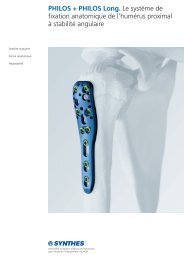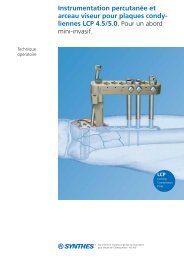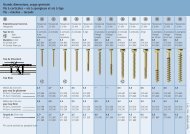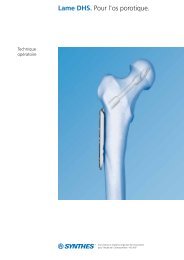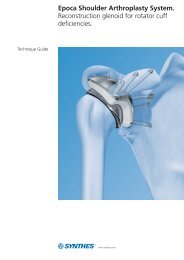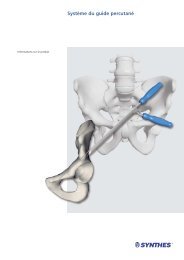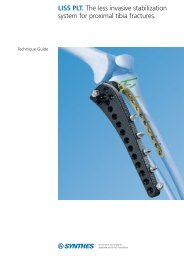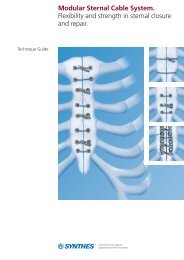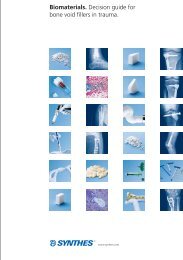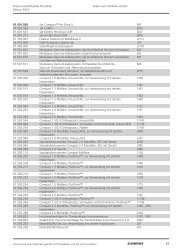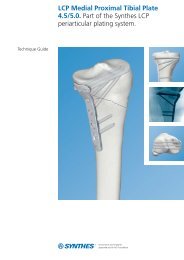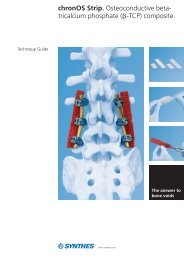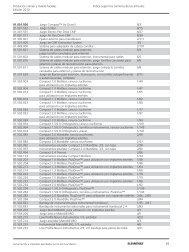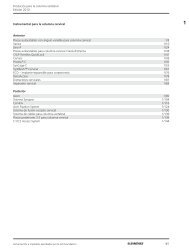Create successful ePaper yourself
Turn your PDF publications into a flip-book with our unique Google optimized e-Paper software.
Technique Guide<strong>LCP</strong> <strong>Wrist</strong> <strong>Fusion</strong> <strong>Set</strong>. Anatomic platesfor total wrist fusion.
Table of ContentsIntroduction<strong>LCP</strong> <strong>Wrist</strong> <strong>Fusion</strong> System 2AO Principles 4Indications 5Surgical TechniquePreoperative Planning 6Approach 7Prepare Joint and Optional Bone Void Filler Insertion 8Insert Distal Cortex Screws 9Insert Distal Locking Screws 11Insert Proximal Cortex Screws 13Insert Proximal Locking Screws 15Close and Optional Implant Removal 17Product InformationScrews 18Plates 20Instruments 21<strong>Set</strong> Lists 24Biomaterials 28Image intensifier controlWarningThis description alone does not provide sufficient background for direct use ofthe instrument set. Instruction by a surgeon experienced in handling theseinstrument is highly recommended.Reprocessing, Care and Maintenance of<strong>Synthes</strong> InstrumentsFor general guidelines, function control and dismantling of multipart instrumentsplease refer to: www.synthes.com/reprocessing<strong>Synthes</strong> 1
<strong>LCP</strong> <strong>Wrist</strong> <strong>Fusion</strong> SystemThe <strong>LCP</strong> <strong>Wrist</strong> <strong>Fusion</strong> System consists of plates, lockingscrews and cortex screws. Implants are available in stainlesssteel and titanium.Plates– Standard bend plates for average-sized individuals– Short bend plates for small-stature individuals or patientswith previous proximal row carpectomy– Straight plate for patients with unusual anatomy or aseverely deformed wrist joint– Precontoured plates reduce the need for intraoperativebending– Low-profile plates minimize plate prominence– Limited-contact design minimizes periosteal contact– <strong>Fusion</strong> angle of 10° dorsiflexion provides optimum handposition– Plates accept 2.7 mm locking and 2.4/2.7 mm cortexscrews distally and 3.5 mm locking and cortex screwsproximally– Plate geometry is identical to the LC-DCP wrist fusionplates, except for overall length– Combi hole dorsal to the capitate allows lagging or lockingthe capitate to the plate2 <strong>Synthes</strong> <strong>LCP</strong> <strong>Wrist</strong> <strong>Fusion</strong> <strong>Set</strong> Technique Guide
Screws– 2.7 mm and 3.5 mm locking screws– 2.4/2.7/3.5 cortex screws– Self-tapping for easy insertion– Self-retaining Stardrive recess provides improved torquetransmission and increased resistance to stripping– Locking screws with threaded head are used in Combiholes to create a fixed-angle construct, particularlyadvantageous to osteopenic bone2.7 mm Locking Screw3.5 mm Locking Screw2.4 mm Cortex Screw2.7 mm Cortex Screw3.5 mm Cortex Screw2.7 mm* 3.5 mm* Distal holes accept 2.4 mm cortex screws also<strong>Synthes</strong> 3
AO PrinciplesIn 1958, the AO formulated four basic principles, which havebecome the guidelines for internal fixation. 1 These principlesas applied to the <strong>LCP</strong> <strong>Wrist</strong> <strong>Fusion</strong> System, are:Anatomic reductionThe <strong>LCP</strong> <strong>Wrist</strong> <strong>Fusion</strong> System consists of implants designed torestore the anatomy of the wrist after fusion.Stable fixationThe implants in the <strong>LCP</strong> <strong>Wrist</strong> <strong>Fusion</strong> System use lockingcompression plate (<strong>LCP</strong>) technology. Locking the screw to theplate creates a fixed-angle construct that is stronger comparedto a similar nonlocking plate and screw combination.The compression screw allows controlled compression of thejoint that increases stability and promotes bony union.Preservation of blood supplyThe plates are low profile to allow good soft tissue coverageand improved blood supply to the fusion site.Early, active mobilization<strong>LCP</strong> <strong>Wrist</strong> <strong>Fusion</strong> Plates combined with proper AO techniqueprovide stable fusion plating with minimal trauma to the vascularsupply. This helps to create an improved environmentfor bone healing, accelerating the patient’s return to activity.1 Müller ME, Allgöwer M, Schneider R, and Willenegger H (1991) AO Manual ofInternal Fixation. 3rd Edition. Berlin: Springer-Verlag4 <strong>Synthes</strong> <strong>LCP</strong> <strong>Wrist</strong> <strong>Fusion</strong> <strong>Set</strong> Technique Guide
IndicationsThe <strong>LCP</strong> <strong>Wrist</strong> <strong>Fusion</strong> System is indicated for wrist arthrodesisand fractures of other small bones of the carpus. Specificindications include:– Posttraumatic arthrosis of the joints of the wrist– Rheumatoid wrist deformities requiring restoration– Complex carpal instability– Postseptic arthritis of the wrist– Severe unremitting wrist pain related to motion– Brachial plexus nerve palsies– Tumor resection– Spastic deformities<strong>Synthes</strong> 5
Preoperative PlanningEvaluate the condition of the soft tissues. Compare the standardbend, short bend and straight plates to the patient'swrist, and determine which plate to use for fusion.The standard bend plate is used for medium to large wristfixation.The short bend plate is used for smaller wrist fixation and forfusion following proximal row carpectomy.The straight plate is used for wrist fixation when the standardand short bend plates do not fit the anatomy. This platecan be contoured to the anatomy of the patient's wrist.6 <strong>Synthes</strong> <strong>LCP</strong> <strong>Wrist</strong> <strong>Fusion</strong> <strong>Set</strong> Technique Guide
Approach1ApproachPlace the patient in the supine position with the hand andarm on a hand table. Make a longitudinal incision from theradial aspect of the third metacarpal across Lister's tubercleto the dorsum of the distal radius.Open the third dorsal compartment, and transpose the extensorpollicis longus (EPL) radially. Retract the digital extensorsof the index and middle fingers to expose the dorsalaspect of the third metacarpal.Make an incision through the wrist capsule and extend itproximally to the radius along its dorsal surface. Elevate thecapsule and second dorsal compartment radially, and thecapsule and fourth dorsal compartment ulnarly.<strong>Synthes</strong> 7
Prepare Joint and Optional Bone Void Filler Insertion2Prepare jointExpose and decorticate the joint surfaces to be included inthe fusion. These include the scaphocapitate joint, capitolunatejoint, radioscaphoid joint and radiolunate joint. In somecases, the ulnar midcarpal, lunotriquetral and second andthird carpometacarpal joints may be included.Remove Lister's tubercle and the dorsal distal aspect of theradius with an osteotome. Decorticate the dorsal surfaces ofthe scaphoid, lunate, and capitate.The dorsal shavings can be saved for use as cancellous bonegraft. Cancellous bone can also be harvested from the radius,radial to the most distal screw position. If more bone isneeded, it may also be obtained from the olecranon or iliaccrest.Insert bone graft (optional)Determine if there is a bone void that requires filling to maintainreduction and aid in bone healing. Use autogenousbone graft or a synthetic bone graft or allograft product(see page 28).Pack all joints to be fused with cancellous bone before platefixation.Dorsal shaving siteJoints to fuseAlways fuseOptional8 <strong>Synthes</strong> <strong>LCP</strong> <strong>Wrist</strong> <strong>Fusion</strong> <strong>Set</strong> Technique Guide
Insert Distal Cortex Screws3Insert distal 2.4 or 2.7 mm cortex screws2.4 mm or 2.7 mm 3.5 mmInstruments311.430 Handle with Quick Coupling,length 110 mm314.467 Screwdriver Shaft, Stardrive, T8,self-holding319.005 Depth Gauge for Screws 2.0 and2.4 mm, measuring range up to 40 mm319.010 Depth Gauge for Screws 2.7 to 4.0 mm,measuring range up to 60 mm310.509 Drill Bit 1.8 mm, with marking,length 110/85 mm, 2-flute310.534 Drill Bit 2.0 mm, with marking,length 110/85 mm, 2-flute323.202 Universal Drill Guide 2.4323.260 Universal Drill Guide 2.71 3 2Sequence of screw placement4 6 5 7 8Bone graftFix the plate to the third metacarpal and then to the radius.Insert screws in the sequence shown. Position the platedirectly over the dorsal aspect of the third metacarpal.Note: Screw sequence may vary depending on patientanatomy and surgeon preference.Place the drill guide in the nonlocking portion of the hole 1in the neutral position.Insert the 1.8 mm drill bit through the 2.4 mm drill guide tothe bone for 2.4 mm cortex screws.Insert the 2.0 mm drill bit through the 2.7 mm drill guide tothe bone for 2.7 mm cortex screws.Caution: Do not start drilling until the drill bit touches thebone. Inserting the drill bit into the drill guide while the drillis running may cause damage to the drill bit or drill guide.Drill to the desired depth, being sure to drill precisely in themidline, dorsal to volar. Verify drill depth using image intensification.<strong>Synthes</strong> 9
Insert Distal Cortex ScrewsRemove the drill and drill guide. Use the depth gauge tomeasure for screw length.Insert the cortex screw, using the self-retaining StarDrivescrewdriver shaft and handle, and tighten carefully.Alternative technique: Insert distal locking screwA unicortical locking screw can be inserted in the threadedportion of the distal hole instead of the cortex screw.This unicortical locking screw can limit fracture propagationat the end of the plate.The technique for inserting a locking screw is described onpage 11.10 <strong>Synthes</strong> <strong>LCP</strong> <strong>Wrist</strong> <strong>Fusion</strong> <strong>Set</strong> Technique Guide
Insert Distal Locking Screws4Insert distal 2.7 mm locking screws2.7 mm 3.5 mmInstruments311.430 Handle with Quick Coupling,length 110 mm314.467 Screwdriver Shaft, Stardrive, T8,self-holding323.033 <strong>LCP</strong> Drill Sleeve for <strong>LCP</strong> Screws 2.7 mm(head <strong>LCP</strong> 2.4), with Scale up to 30 mm,for Drill Bits 2.0 mm310.534 Drill Bit 2.0 mm, with marking,length 110/85 mm, 2-flute511.776 Torque Limiter, 0.8 Nm, forAO/ASIF Quick Coupling1 3 2Sequence of screw placement4 6 5 7 8Insert locking screw in the sequence shown (2, 3, 4).Screw the threaded drill guide into the locking portion of the<strong>LCP</strong> hole.For 2.7 mm locking screws use the 2.0 mm drill bit and the2.7 mm <strong>LCP</strong> drill sleeve.<strong>Synthes</strong> 11
Insert Distal Locking ScrewsInsert the drill bit through the drill guide to the bone.Caution: Do not start drilling until the drill bit touches thebone. Inserting the drill bit into the drill guide while the drillis running may cause damage to the drill bit or drill guide.Drill to the desired depth. Verify drill depth using imageintensification.Determine the screw length directly from the mark on thedrill bit and the scale on the threaded drill guide, or use thecorresponding depth gauge.Alternative instrument319.010 Depth Gauge for Screws 2.7 to 4.0 mm,measuring range up to 60 mmScrew length can be checked by removing the drill guide andusing the depth gauge.Insert the locking screw using the self-retaining StarDrivescrewdriver shaft and handle, and tighten carefully. Excessiveforce is not necessary to lock the screw to the plate. Repeatfor the remaining locking screws.Fix the plate to the capitate in a similar manner.Note: If the plate sits off of the dorsal capitate, be carefulnot to lag the capitate up to the plate. This would distort thecarpal canal and lead to volar screw prominence.Technique tip: insert the self-tapping 2.7 mm lockingscrews with the 0.8 Nm torque limiting attachment.12 <strong>Synthes</strong> <strong>LCP</strong> <strong>Wrist</strong> <strong>Fusion</strong> <strong>Set</strong> Technique Guide
Insert Proximal Cortex Screws5Insert 3.5 mm cortex screws2.7 mm 3.5 mmInstruments310.250 Drill Bit 2.5 mm, length 110/85 mm,2-flute, for Quick Coupling311.430 Handle with Quick Coupling,length 110 mm314.116 Screwdriver Shaft Stardrive 3.5, T15,self-holding319.010 Depth Gauge for Screws 2.7 to 4.0 mm,measuring range up to 60 mm323.360 Universal Drill Guide 3.5Also available311.420 Handle, large, with Quick Coupling,length 155 mm314.030 Screwdriver Shaft, hexagonal, small, 2.5 mm1 3 2Sequence of screw placement4 6 5 7 8In aligning the plate over the radius, a small amount of ulnardeviation may be preferred.With the plate aligned and the hand properly positioned,begin fixation to the radius with hole 5.Place the drill guide in the nonlocking portion of hole 5 inthe load position.Insert the 2.5 mm drill bit through the drill guide to thebone.Caution: Do not start drilling until the drill bit touches thebone. Inserting the drill bit into the drill guide while the drillis running may cause damage to the drill bit or drill guide.Drill to the desired depth. Verify drill depth using imageintensification.<strong>Synthes</strong> 13
Insert Proximal Cortex ScrewsRemove the drill and drill guide. Measure for screw lengthusing the depth gauge.Insert a 3.5 mm cortex screw, using the self-retaining Stardrivescrewdriver shaft and handle, and tighten carefully.Alternative technique: Insert 3.5 mm locking screwA unicortical locking screw can be inserted in the threadedportion of the hole instead of the cortex screw.The technique for inserting a 3.5 mm locking screw isdescribed on page 15.14 <strong>Synthes</strong> <strong>LCP</strong> <strong>Wrist</strong> <strong>Fusion</strong> <strong>Set</strong> Technique Guide
Insert Proximal Locking Screws6Insert proximal 3.5 mm locking screws2.7 mm 3.5 mmInstruments310.288 Drill Bit 2.8 mm, length 165 mm311.430 Handle with Quick Coupling,length 110 mm323.027 <strong>LCP</strong> Drill Sleeve 3.5, for Drill Bits 2.8 mm314.116 Screwdriver Shaft Stardrive 3.5, T15,self-holding319.010 Depth Gauge for Screws 2.7 to 4.0 mm,measuring range up to 60 mm511.773 Torque Limiter, 1.5 Nm, for AO/ASIF QuickCouplingAlso available311.420 Handle, large, with Quick Coupling,length 155 mm314.030 Screwdriver Shaft, hexagonal, small, 2.5 mm1 3 2Sequence of screw placement4 6 5 7 8Insert screws in the sequence shown (6, 7, 8).Screw the drill guide into the locking portion of the <strong>LCP</strong>hole.Insert the 2.8 mm drill bit through the drill guide to thebone.Caution: Do not start drilling until the drill bit touches thebone. Inserting the drill bit into the drill guide while the drillis running may cause damage to the drill bit or drill guide.Drill to the desired depth. Verify drill depth using imageintensification.Important: Use of the 1.5 Nm torque limiting attachmentrequired for 3.5 mm locking screws.<strong>Synthes</strong> 15
Insert Proximal Locking ScrewsRemove the drill and drill guide. Measure for screw lengthusing the depth gauge.Insert a 3.5 mm locking screw, using the self-retainingStardrive screwdriver shaft and handle, and tighten carefully.Excessive force is not necessary to lock the screw to theplate. Repeat for the remaining 3.5 mm locking screws.16 <strong>Synthes</strong> <strong>LCP</strong> <strong>Wrist</strong> <strong>Fusion</strong> <strong>Set</strong> Technique Guide
Close and Optional Implant Removal7CloseClose the wound in a routine fashion. Close the capsule overthe plate as completely as possible. Leave the EPL radiallytransposed and check that it does not rub against the plate.Apply a soft, bulky dressing and/or splint to protect the wristImplant removal (optional)To remove locking screws, unlock all screws from the plateand then begin to remove the screws completely fromthe bone. This avoids rotation of the plate when removingthe last locking screw.<strong>Synthes</strong> 17
Screws Used with the <strong>LCP</strong> <strong>Wrist</strong> <strong>Fusion</strong> PlatesStainless Steel and Titanium2.4 mm Cortex Screws*– For use in the nonlocking portion of combi-holes in thedistal plate shaft– Provide compression or neutral fixation– T8 StarDrive recess– Self-tapping– 10 mm–24 mm lengths (2 mm increments)2.7 mm Locking Screws*– For use in the locking portion of combi-holes in the distalplate shaft– Threaded, conical head– T8 StarDrive recess– Self-tapping– 10 mm to 24 mm lengths (2 mm increments)2.7 mm Cortex Screws*– For use in the nonlocking portion of combi-holes in thedistal plate shaft– Provide compression or neutral fixation– T8 StarDrive recess– Self-tapping– 10 mm–24 mm lengths (2 mm increments)* All screws are made of stainless steel or titanium alloy and are available in amodular screw rack.18 <strong>Synthes</strong> <strong>LCP</strong> <strong>Wrist</strong> <strong>Fusion</strong> <strong>Set</strong> Technique Guide
3.5 mm Locking Screws*– For use in the locking portion of combi-holes in theproximal plate shaft– Threaded, conical head– T15 StarDrive or hex recess– Self-tapping– 12 mm–28 mm lengths (2 mm increments)3.5 mm Cortex Screws*– For use in the nonlocking portion of combi-holes in theproximal plate shaft– Provide compression or neutral fixation– T15 StarDrive or hex recess– Self-tapping– 12 mm–28 mm lengths (2 mm increments)* All screws are made of stainless steel or titanium alloy and are available in amodular screw rack.<strong>Synthes</strong> 19
<strong>LCP</strong> <strong>Wrist</strong> <strong>Fusion</strong> PlatesStainless Steel and TitaniumStandard bendStainless Steel Titanium Length02.110.150 04.110.150 118 mmShort bendStainless Steel Titanium Length02.110.151 04.110.151 118 mmStraightStainless Steel Titanium Length02.110.152 04.110.152 112 mmNote: All plates are also available in sterile.All plates are made of Stainless Steel or pure Titanium.20 <strong>Synthes</strong> <strong>LCP</strong> <strong>Wrist</strong> <strong>Fusion</strong> <strong>Set</strong> Technique Guide
Instruments310.250 2.5 mm Drill Bit, quick coupling, 110 mm310.288 2.8 mm Drill Bit, quick coupling, 165 mm310.509 Drill Bit 1.8 mm, with marking,length 110/85 mm, 2-flute310.534 Drill Bit 2.0 mm, with marking,length 110/85 mm, 2-flute,for Quick Coupling311.430 Handle, with quick coupling311.420 Handle, large, with Quick Coupling,length 155 mm323.027 2.8 mm Threaded Drill Guide, for 3.5 mmlocking screws314.116 Stardrive Screwdriver Shaft, T15,self-retaining, quick coupling314.030 Screwdriver Shaft, hexagonal, small, 2.5 mm<strong>Synthes</strong> 21
Instruments314.467 StarDrive Screwdriver Shaft, T8319.005 Depth Gauge for Screws 2.0 and2.4 mm, measuring range up to 40 mm319.010 Depth Gauge, for 2.7 mm and 3.5 mmscrews up to 60 mm323.033 <strong>LCP</strong> Drill Sleeve for <strong>LCP</strong> Screws 2.7 mm(head <strong>LCP</strong> 2.4), with Scale up to 30 mm,for Drill Bits 2.0 mm323.202 Universal Drill Guide 2.4323.260 Universal Drill Guide 2.7323.360 Universal Drill Guide 3.522 <strong>Synthes</strong> <strong>LCP</strong> <strong>Wrist</strong> <strong>Fusion</strong> <strong>Set</strong> Technique Guide
511.773 Torque Limiter, 1.5 Nm, for AO/ASIFQuick Coupling511.776 Torque Limiter, 0.8 Nm, for AO/ASIFQuick Coupling<strong>Synthes</strong> 23
<strong>LCP</strong> <strong>Wrist</strong> <strong>Fusion</strong> Implant Module <strong>Set</strong>sTitanium (01.111.433) and Stainless Steel (01.111.434)Vario Case68.111.423 Tray for <strong>LCP</strong> <strong>Wrist</strong> <strong>Fusion</strong> Plates2.7/3.5, size 1/4,without Lid, without Contents68.000.102 Lid for Instrument Tray, size 1/4Implants<strong>LCP</strong> <strong>Wrist</strong> <strong>Fusion</strong> PlatesStainless Steel Titanium Description02.110.150 04.110.150 standard bend02.110.151 04.110.151 short bend02.110.152 04.110.152 straight24 <strong>Synthes</strong> <strong>LCP</strong> <strong>Wrist</strong> <strong>Fusion</strong> <strong>Set</strong> Technique Guide
<strong>LCP</strong> <strong>Wrist</strong> <strong>Fusion</strong> Instrument <strong>Set</strong> (01.110.080)Vario Case68.111.422 Tray for Instrument <strong>Set</strong>,for <strong>LCP</strong> Plates 2.4/2.7/3.5, size 1/2,without Lid, without Contents684.060 Lid for Instrument Tray (without Labelling)Instruments310.509 Drill Bit 1.8 mm310.534 Drill Bit 2.0 mm310.250 Drill Bit 2.5 mm310.288 Drill Bit 2.8 mm319.005 Depth Gauge for Screws 2.0 and 2.4 mm319.010 Depth Gauge for Screws 2.7 to 4.0 mm323.202 Universal Drill Guide 2.4323.260 Universal Drill Guide 2.7323.360 Universal Drill Guide 3.5323.029 <strong>LCP</strong> Drill Sleeve 2.4, with Scale up to30 mm, for Drill Bits 1.8 mm323.033 <strong>LCP</strong> Drill Sleeve for <strong>LCP</strong> Screws 2.7 mm(head <strong>LCP</strong> 2.4), with Scale up to 30 mm,for Drill Bits 2.0 mm323.027 <strong>LCP</strong> Drill Sleeve 3.5, for Drill Bits 2.8 mm314.116 Screwdriver Shaft Stardrive 3.5, T15,self-holding314.467 Screwdriver Shaft, Stardrive, T8,self-holding314.030 Screwdriver Shaft, hexagonal, small, 2.5 mm314.453 Screwdriver Shaft Stardrive 2.4, short,self-holding311.420 Handle, large, with Quick Coupling,length 155 mm311.430 Handle with Quick Coupling,length 110 mm319.970 Screw Forceps, self-holding, length 85 mm511.773 Torque Limiter, 1.5 Nm, for AO/ASIFQuick Coupling511.776 Torque Limiter, 0.8 Nm, for AO/ASIFQuick Coupling<strong>Synthes</strong> 25
<strong>LCP</strong> <strong>Wrist</strong> <strong>Fusion</strong> Instrument and Implant <strong>Set</strong>sTitanium01.110.082* Instruments and Implant <strong>Set</strong> with 2.7Stardrive/3.5 Hex, for <strong>LCP</strong> <strong>Wrist</strong> <strong>Fusion</strong>Plates01.110.080 <strong>LCP</strong> Instrument <strong>Set</strong> 2.4/2.7/3.501.111.433 <strong>LCP</strong> <strong>Wrist</strong> <strong>Fusion</strong> Implant <strong>Set</strong> 2.7/3.5,Pure Titanium01.110.083* Instruments and Implant <strong>Set</strong> with2.7/3.5 Stardrive, for<strong>LCP</strong> <strong>Wrist</strong> <strong>Fusion</strong> Plates01.110.080 <strong>LCP</strong> Instrument <strong>Set</strong> 2.4/2.7/3.501.111.433 <strong>LCP</strong> <strong>Wrist</strong> <strong>Fusion</strong> Implant <strong>Set</strong> 2.7/3.5,Pure TitaniumStainless Steel01.110.092* Instruments and Implant <strong>Set</strong> with 2.7Stardrive/3.5 Hex, for <strong>LCP</strong> <strong>Wrist</strong> <strong>Fusion</strong>Plates01.110.080 <strong>LCP</strong> Instrument <strong>Set</strong> 2.4/2.7/3.501.111.434 <strong>LCP</strong> <strong>Wrist</strong> <strong>Fusion</strong> Implant <strong>Set</strong> 2.7/3.5,Stainless Steel01.110.093* Instruments and Implant <strong>Set</strong> with2.7/3.5 Stardrive, for<strong>LCP</strong> <strong>Wrist</strong> <strong>Fusion</strong> Plates01.110.080 <strong>LCP</strong> Instrument <strong>Set</strong> 2.4 / 2.7 / 3.501.111.434 <strong>LCP</strong> <strong>Wrist</strong> <strong>Fusion</strong> Implant <strong>Set</strong> 2.7/3.5,Stainless SteelAlso included in the set68.111.464 Labelling Clip for<strong>LCP</strong> <strong>Wrist</strong> <strong>Fusion</strong> Plate <strong>Set</strong>* each set contains a modular screw rack containing the appropriate screws26 <strong>Synthes</strong> <strong>LCP</strong> <strong>Wrist</strong> <strong>Fusion</strong> <strong>Set</strong> Technique Guide
Modular Screwrack68.111.442 Lid for Modular Screw Rack for screws2.0mm–3.5mm68.000.103 Screw Rack Frame, size 1/4, height 3568.111.439 Screw Rack Module, 1/3, for 2.4 mmscrews, for 1/4 frame68.111.440 Screw Rack Module, 1/3, for 2.7 mmscrews, for 1/4 frame68.111.441 Screw Rack Module, 1/3, for 3.5 mmscrews, for 1/4 frame<strong>Synthes</strong> 27
<strong>Synthes</strong> Biomaterials OverviewSynthetic and allogenic bone replacementmaterials have the advantage ofuniform quality, unlimited availabilityand absence of potential complicationsat a donor site.Additionally, the application of syntheticand allogenic bone graft substitutesreduces the duration of the surgery.<strong>Synthes</strong> offers a wide range of syntheticbiomaterial products in differentapplication forms and with distinct biologicalproperties:chronOSchronOS Perfusion ConceptchronOS InjectOsteoconductive, resorbable, synthetic Enhancing chronOS with biological factors Injectable remodellingNorian SRSDBX*Injectable stabilityOsteoinductive power*Facilitated through <strong>Synthes</strong>Furthermore a comprehensive portfolioof allograft products is available inselected countries.For more detailed information about aspecific product or availability of allograftsplease contact your local <strong>Synthes</strong>representative.28 <strong>Synthes</strong> <strong>LCP</strong> <strong>Wrist</strong> <strong>Fusion</strong> <strong>Set</strong> Technique Guide
<strong>Synthes</strong> GmbHEimattstrasse 3CH-4436 Oberdorfwww.synthes.comAll technique guides are available as PDF files atwww.synthes.com/litÖ036.000.700öAAVä0123036.000.700 SE_199329 AA 30080058 © 12/2008 <strong>Synthes</strong>, Inc. or its affiliates All rights reserved <strong>Synthes</strong> and <strong>LCP</strong> <strong>Wrist</strong> <strong>Fusion</strong> <strong>Set</strong> are trademarks of <strong>Synthes</strong>, Inc. or its affiliates



